Import WorldServer package
SDL Worldserver files are packages that contain XLIFF documents, translation memories, and term bases. In memoQ, you can import and work with WorldServer packages.
WorldServer package files have the *.xlz or *.wsxz extension.
You can import WorldServer packages into local or online projects.
Project manager edition and memoQ server may be required: To import a WorldServer package into an online project, you need the project manager edition of memoQ, and access to a memoQ server or memoQ cloud.
How to get here
To import a WorldServer package into a local project:
- Save the WorldServer package file to your Documents folder. (Or, use any other folder that you can easily open.)
If you are using the project manager edition of memoQ: At the top of the Dashboard, from the server selector, choose My Computer.
- On the Project ribbon, click Import package.
- An Open window opens. Find the folder where the package file is, and double-click the file. The Import WorldServer package wizard starts.
To import a WorldServer package into an online project:
Project manager edition required: Make sure you are running the project manager edition of memoQ.
- Save the WorldServer package file to your Documents folder. (Or, use any other folder that you can easily open.)
- At the top of the Dashboard, from the server selector, choose or type the address of the server where you want to import the package.
You may need to log in: If you access this server for the first time, the Log in to server window opens. You need a user name and a password to access the server.
- On the Project ribbon, click Import package.
- An Open window opens. Find the folder where the package file is, and double-click the file. The Import WorldServer package wizard starts. This time it looks like the Publish project wizard.
What can you do?
The first page of the Import WorldServer package wizard looks like the Project information page of the New memoQ project wizard.
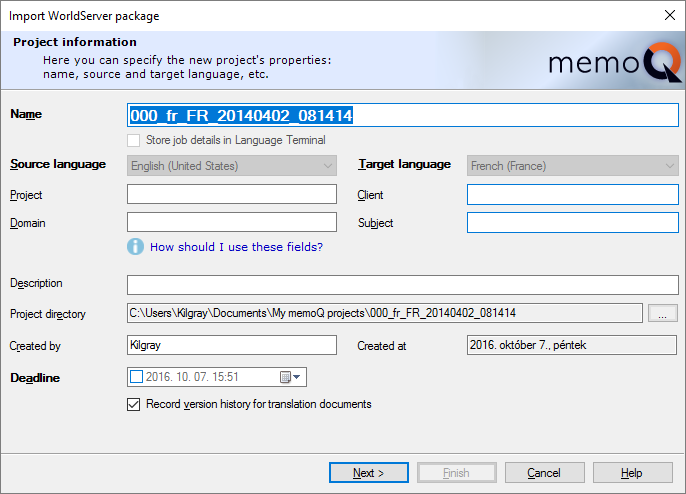
memoQ automatically suggests a project name, and fills in the languages. You need to fill in the Project, Client, Domain and Subject values are taken from the WorldServer project. You can change the details here.
Click Next to continue.
On the second screen, you can tell memoQ how to import the documents in the package. More precisely, you can configure how memoQ should import and export segment statuses and match rates (of pre-translated segments).
In addition, you can import or ignore the terminology and the translation memory that come with the WorldServer package.
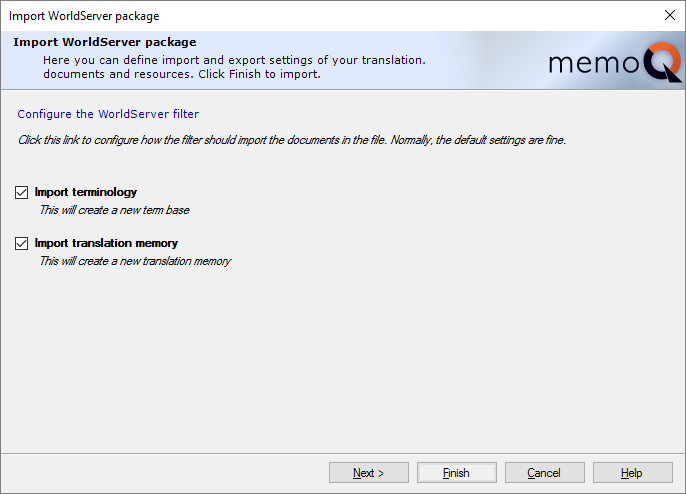
To configure how documents are imported: Click the Configure the WorldServer filter link. A WorldServer package contains either WorldServer XLIFF files or SDLXLIFF files. The Document import settings window that opens will have settings both for WorldServer XLZ and SDLXLIFF. To learn what you can set up, see the Help page of the WorldServer XLF filter.
On this screen, you can also import or ignore the resources in the package. Normally, memoQ imports the terminology and the translation memory from the package. This is how it should be. It's not recommended to clear the Import terminology or the Import translation memory check box, unless you know for certain that the contents are irrelevant or unreliable.
The package will contain the translation memory in the form of a TMX file. memoQ will create a new translation memory import the contents from the TMX file. When you click Finish, memoQ will open the New translation memory window first. When the translation memory is created, the Translation memory TMX import settings window will appear.
The package may also contain a term base in the form of a TBX file. memoQ will create a new term base and import the contents from the TBX file. The term base will have the same name as the project. memoQ will also import these descriptive details: definition (language level), creator, creation date, modifier, modification date, part of speech and the forbidden status. memoQ doesn't import languages that are not there in the project.
Importing a WorldServer package into an online project is similar to publishing a local memoQ project to a memoQ server.
Project manager edition required: To import a WorldServer package into an online project, you must use the project manager edition of memoQ.
Before you import a WorldServer package into an online project, make sure you have access to the memoQ server, and you belong to the Project managers or the Administrators group.
For more details: See the documentation about the Publish project wizard.
Normally, the Server URL box will already be filled in because you choose a server before you start importing the package. (You may choose another server, but then memoQ will ask you for a user name and a password for that server.)
- In most cases, you would leave the Server URL as it is. Next to the Server URL box, click Select. memoQ connects to the server.
- If the server is available, the Name of project on server box appears. It's already filled in with the name of the Transit package, but you can choose another name.
If there is another project on the server with the same name: memoQ won't allow you to continue. In that case, change the name in the Name of project on server box.
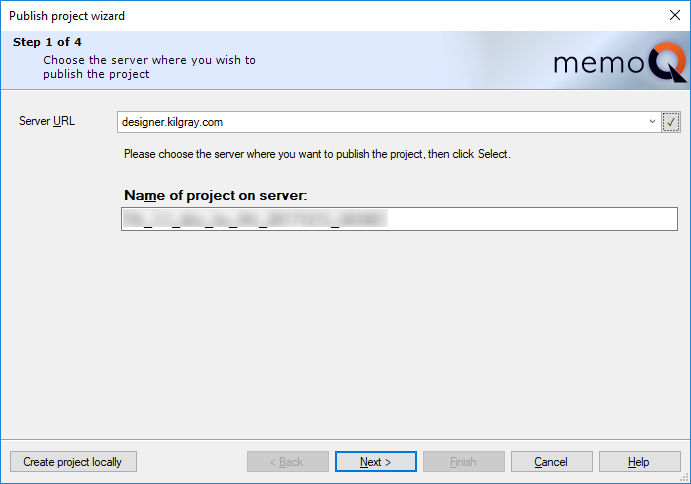
- Click Next to continue.

- Choose the type of workflow this project must use.
In an online project, workflow steps usually run in parallel, so that reviewers don't have to wait for the translators to complete the translation.
Normally, memoQ sets up online projects for the parallel workflow.
However, if some translators or reviewers can't be online all the time, or their connection is unreliable, it may make sense to give them packages. If translators and reviewers work with packages, the workflow phases can't overlap - reviewers must wait until translators deliver at least some of their work.
To allow translators and reviewers to work with packages, check the Allow package creation check box. The Workflow phases can overlap for simultaneous translation and review check box will be greyed out.
- Normally, memoQ is strict about quality assurance. If a document contains quality assurance errors - these are tagging errors or warnings that cannot be dismissed -. the translator cannot deliver the document until these are resolved. It's best to leave it this way. As a rule, don't clear the Users cannot deliver documents with QA errors check box.
- Using external machine translation, terminology, and translation memory services may cause problems with confidentiality. memoQ usually has to send out the source text so that the external source can return suggestions. In many cases, there is a non-disclosure agreement with the client that expressly prohibits this. In these cases, you need to prevent translators and reviewers from using these external sources.
Each user can control which external sources they use: In their own copies of memoQ, translators and reviewers can set up machine translation, terminology, and translation memory plugins. They can use the Options window for this. If you need to prevent them from doing this in an online project, you can disable everything they set up - you don't need to know what they configured for themselves.
Normally, memoQ allows users to reach out to external resources. If you must prevent this, check the Disable machine translation plugins, Disable terminology plugins, and Disable translation memory plugins check boxes. It's best if you disable or enable these together.
After making choices, click Next to continue.
Many of these settings are there for users who have a slow or unreliable connection. You can allow them to have offline copies of the translation memories and term bases. You can also omit the data that memoQ uses to export the documents. Normally, it's the project manager (and not the translator or the reviewer) who exports documents from an online project.
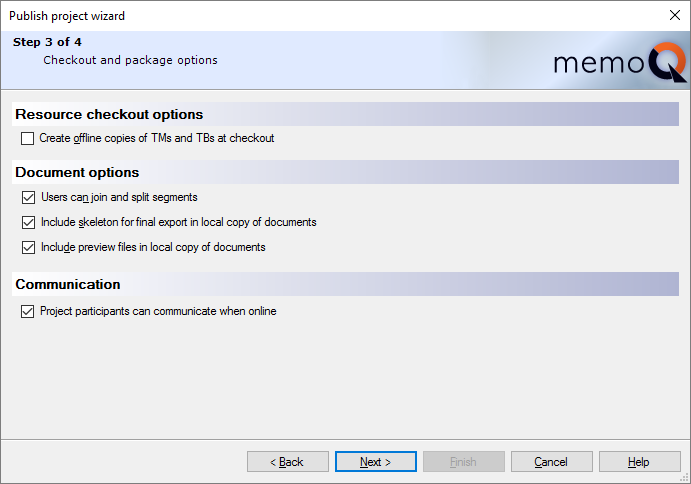
To help users who have a slow or unreliable connection:
- Check the Create offline copies of TMs and TBs at checkout check box.
- Clear the Include skeleton for final export in local copy of documents check box.
- If the connection is very bad, and the user can work without the preview (ask them first!): Clear the Include preview files in local copy of documents check box.
- Clear the Project participants can communicate when online check box.
If the project needs special segmentation that must not change during translation:
Clear the Users can join and split segments check box. If you do this, X-Translate will be more reliable, too. This is important if the source documents change frequently.
Normally, memoQ allows participants to post on forums and chat within memoQ. If you use different communication channels, you can clear the Project participants can communicate when online check box. You need to make sure one thing: that you use a well-established communication channels among translators, reviewers, and project managers.
After making choices, click Next to continue.
On the fourth screen, you can tell memoQ how to import the documents in the package. More precisely, you can configure how memoQ should import and export segment statuses and match rates (of pre-translated segments).
In addition, you can import or ignore the terminology and the translation memory that come with the WorldServer package.
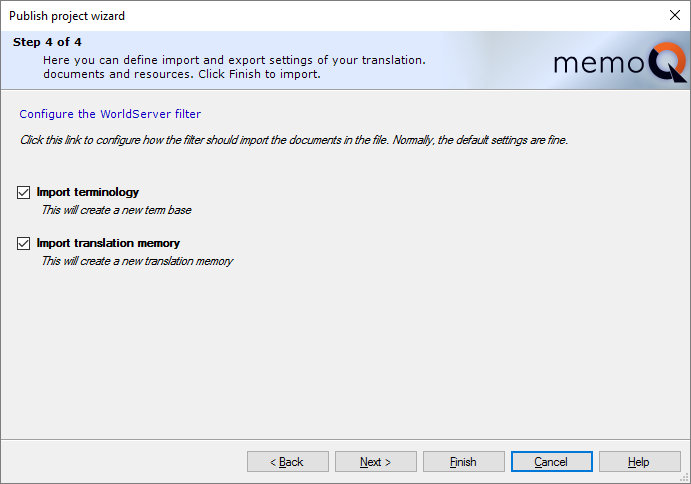
To configure how documents are imported: Click the Configure the WorldServer filter link. A WorldServer package contains either WorldServer XLIFF files or SDLXLIFF files. The Document import settings window that opens will have settings both for WorldServer XLZ and SDLXLIFF. To learn what you can set up, see the Help page of the WorldServer XLF filter.
On this screen, you can also import or ignore the resources in the package. Normally, memoQ imports the terminology and the translation memory from the package. This is how it should be. It's not recommended to clear the Import terminology or the Import translation memory check box, unless you know for certain that the contents are irrelevant or unreliable.
The package will contain the translation memory in the form of a TMX file. memoQ will create a new translation memory import the contents from the TMX file. When you click Finish, memoQ will open the New translation memory window first. When the translation memory is created, the Translation memory TMX import settings window will appear.
The package may also contain a term base in the form of a TBX file. memoQ will create a new term base and import the contents from the TBX file. The term base will have the same name as the project. memoQ will also import these descriptive details: definition (language level), creator, creation date, modifier, modification date, part of speech and the forbidden status. memoQ doesn't import languages that are not there in the project.
To import the package into the online project, click Finish.
When you finish
To import the SDL WorldServer project: Click Finish.
To return to the Dashboard, and not import the package: Click Cancel.
When the translation is finished
To export a WorldServer package from a local project: Open the project. On the Documents ribbon, click the arrow below Export. From the menu, choose Export (stored path).
To export a WorldServer package from an online project: Open the project for management. In the memoQ online project window, choose Translations. Under the list, click Export (stored path).